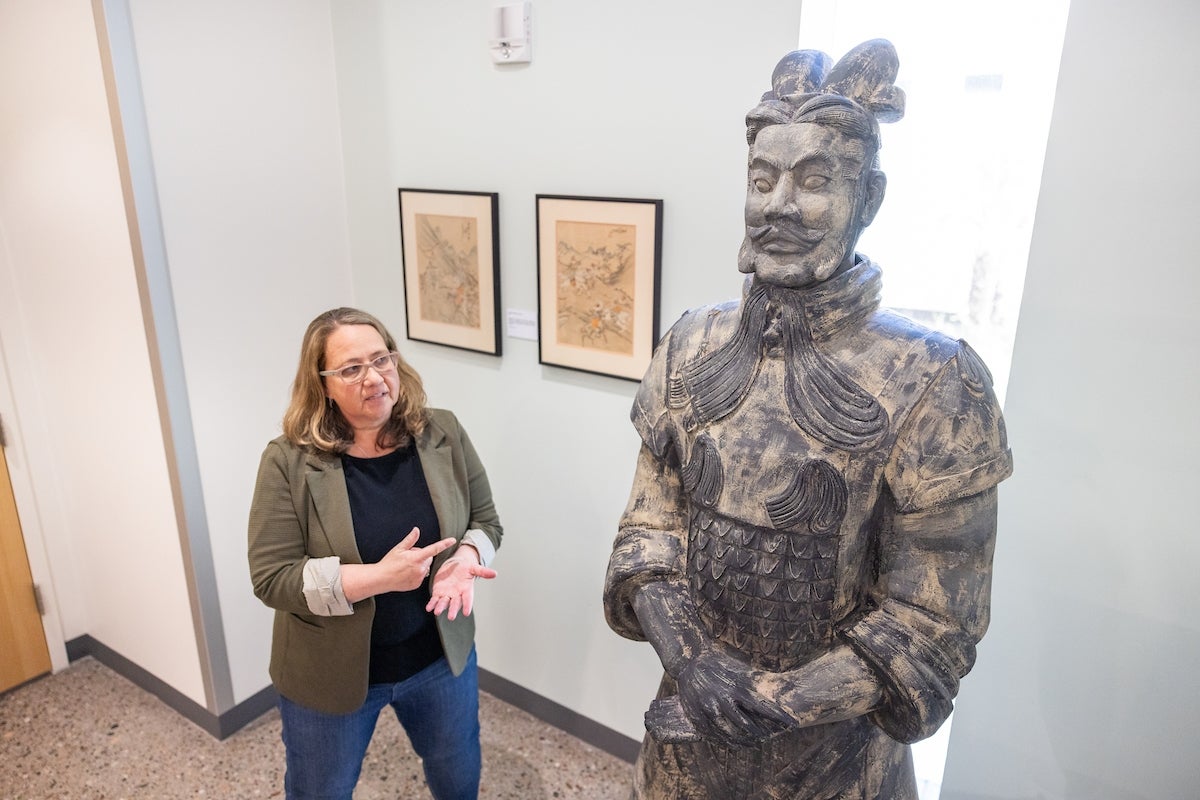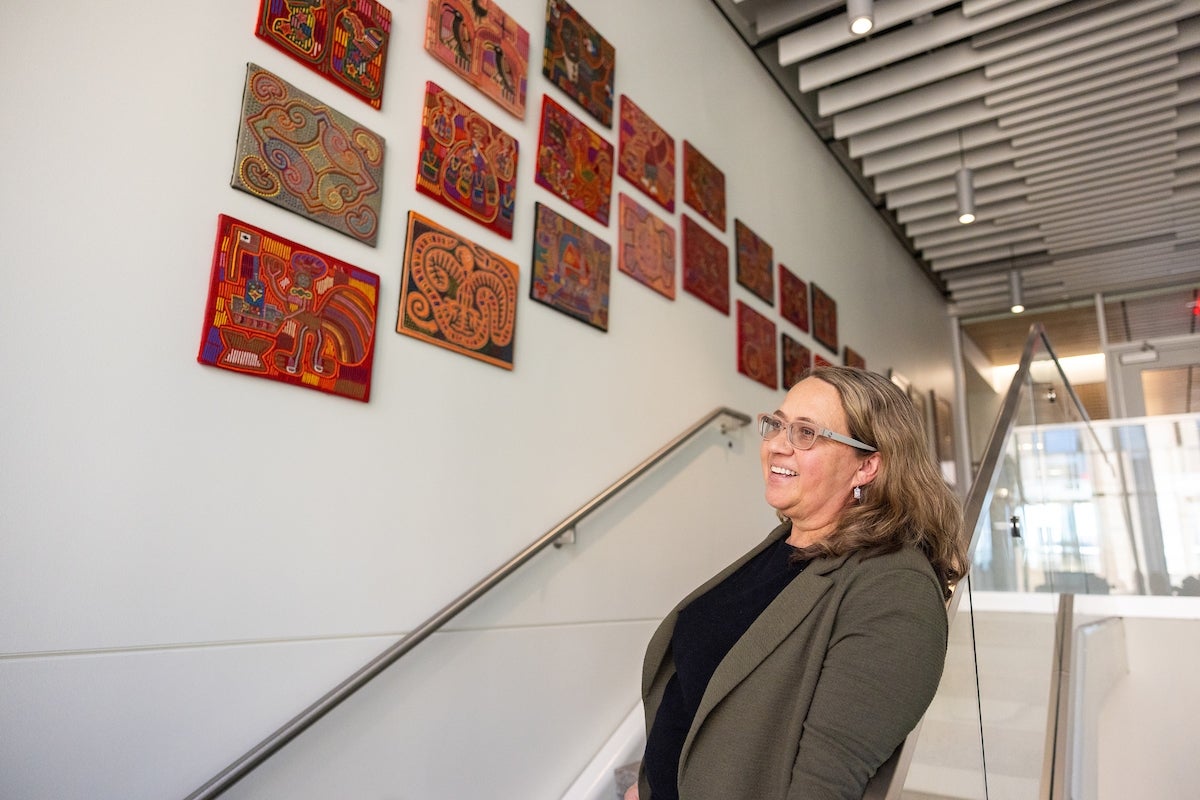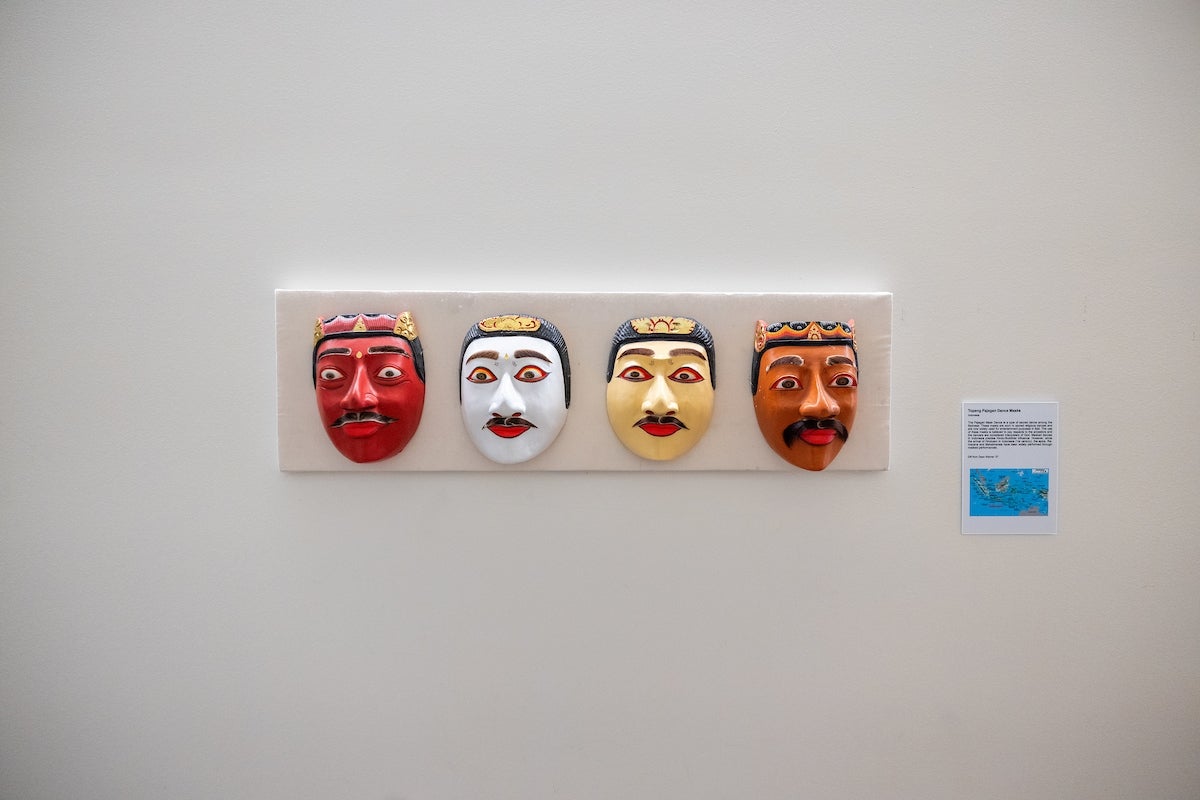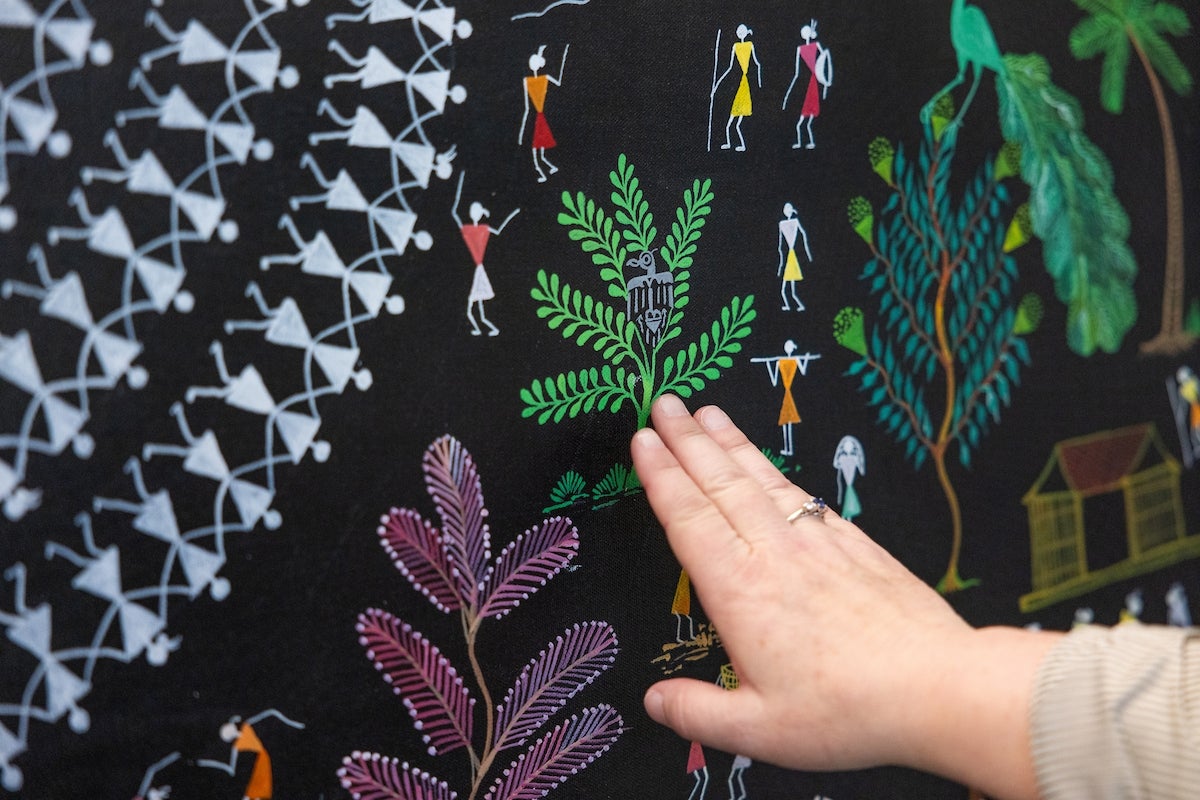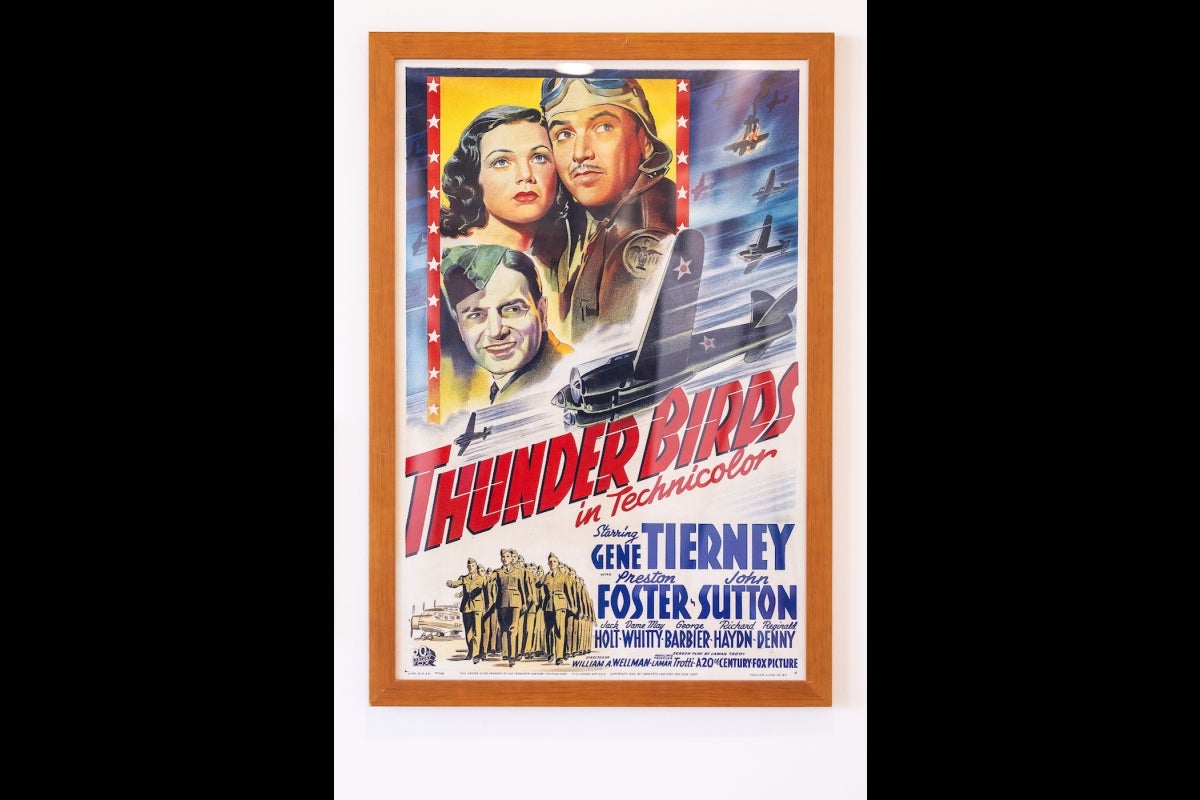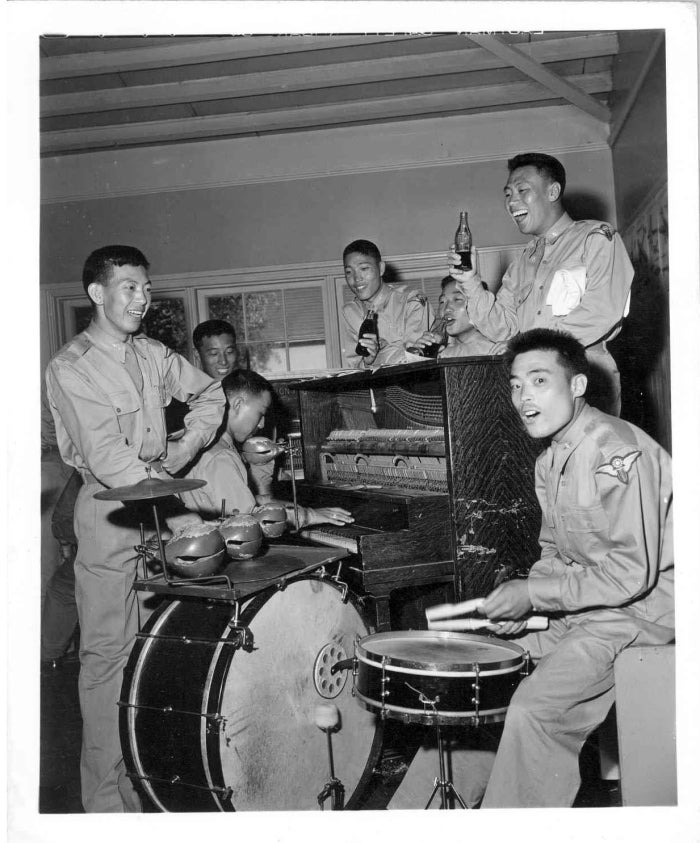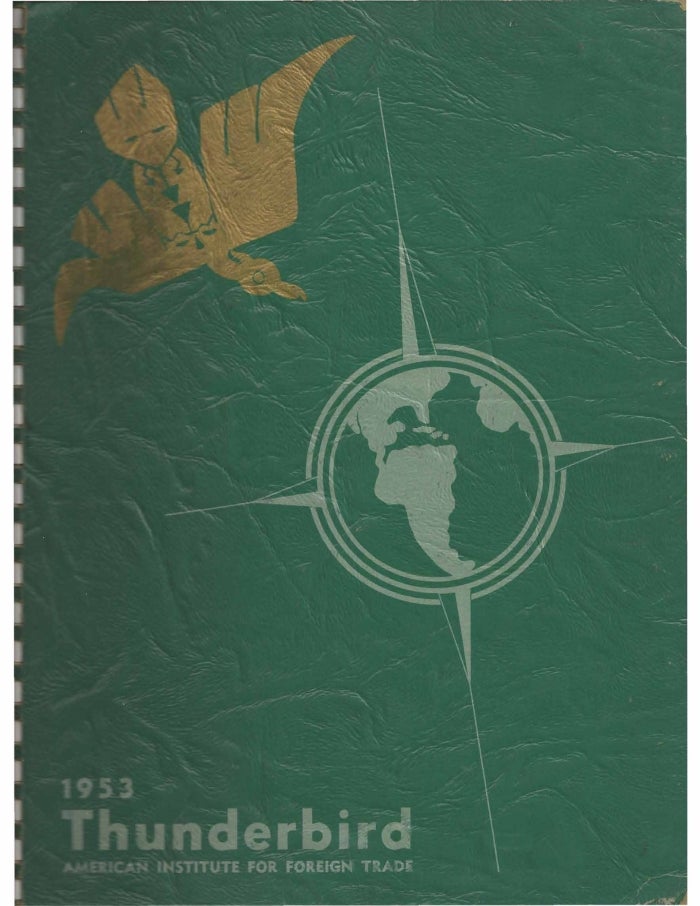Thunderbird archives: These walls do talk

Arizona State University archivist Shannon Walker walks through the Thunderbird archives, which are displayed on each floor of the F. Francis and Dionne Najafi Global Headquarters Thunderbird building in downtown Phoenix. Photo by Deanna Dent/ASU
Editor’s note: This is part of a monthly series spotlighting special collections from ASU Library’s archives throughout 2024.
At most universities, if you want to learn about their history, you must enter a library and dig through an expansive archive. At the Thunderbird School of Global Management on Arizona State University’s Downtown Phoenix campus, a good portion of its history is displayed on its walls.
Spread out over 110,000 square feet and five stories are photos, digital signage, mural panels and artwork from around the world conveying how this history reflects the school’s past, people and programs in a broad, open and engaging way.
“The Thunderbird School of Global Management archives have many layers, and they’re interwoven throughout the whole building and done on a scale that tells our story in a thoughtful and deliberate way,” said Shannon Walker, who currently oversees both the ASU University Archives and the archival collections at Thunderbird School of Global Management. “It showcases our colorful history dating back to World War II while at the same time reflects the diverse cultures of the people who have attended here and have gone on to become renowned global leaders.”
Founded on the grounds of a deactivated airbase (Thunderbird Field No. 1), Thunderbird was the first graduate management school focused exclusively on global business. A unit of Arizona State University since 2014, today it’s regarded as the world’s premier institution in the education of global leaders and managers.
Seventy-seven years ago this month, a contingent of Hollywood actors (including Jimmy Stewart) and businessmen formed a corporation named Southwest Airways to establish a primary flight training school for the Army as World War II loomed. Construction of that school, Thunderbird Field No. 1. was started in January 1941. Flight instruction began three months later and continued through the end of World War II.
“The airfield went up fast, and it was built to last about a decade, but we occupied the campus until 2014,” said Mary Teagarden, deputy dean of Thunderbird Knowledge Enterprise, professor of global strategy and editor-in-chief of the Thunderbird International Business Review. “My father, George Boyden, was a flight instructor and trained many people from many parts of the world. Sadly, many of the Americans he trained went on to be killed in the second World War.”
A photo of Boyden training pilots hangs in a back hallway on the fourth floor of the school, which never fails to elicit a response from Teagarden.
“It’s profoundly moving for me,” Teagarden said. “The history of this place has been well maintained.”
Digging through history
That well-maintained history is in large part due to Nelda Crowell, whose love for the school’s history helped create its first archive. Crowell was hired by Thunderbird in 1983 as director of communications. She said at the time there were no official archives, and what she had located was “a jumble of things in my file.”
“I really valued history and found Thunderbird’s story and history fascinating. Over the years, people would bring me things, and I’d keep what I felt was important in my file cabinet,” said Crowell, who graduated from ASU with a journalism degree and a minor in history. “As years went by, I talked someone in administration (into giving) me a closet in another building that had no number on the door. It was my own little secret hideaway for the archives. It wasn’t an official archive by any means, but there were so many things I felt we couldn’t throw away because they were just too valuable."
Crowell said one of the most valuable discoveries was when a custodian brought her a box filled with broken trophies and a few other items. He asked if he should throw it out. Crowell asked him to set it aside so she could review the items.
“I got to the bottom of the box and there was a scrapbook of clippings from the school’s first year of existence,” Crowell said. “There were also some documents that described our cooperative programs with other countries. That scrapbook was probably the most important thing I had come across.”
The scrapbook informed Crowell that, after the war, the idea to form a new school for international trade was born out of discussions by retired Army colonels and spearheaded by Lt. General Barton Kyle Yount, who wanted to educate mostly American GIs, for the international market.
In six months, these military men were able to obtain financing from Phoenix businesses and New York banks, to remodel the barracks and classrooms, furnish the facility using Army surplus goods, buy books, hire staff and faculty, and publicize their new venture.
They called it the American Institute for Foreign Trade.
The school developed a three-part curriculum that focused on foreign trade, area studies and cross-cultural communication. The early years were dominated by efforts to enroll students and raise money to stay afloat. The school suffered a blow with the death of President Yount, who suffered a heart attack in 1949, three years after the institution opened its doors. The school’s administration rallied and carried on to apply its strategic focus on international education, creating a family-like atmosphere on campus.
Then, another type of family moved into the campus, according to Walker. “From what I understand, the place was overrun with caterpillars,” she said. “Back then, the original site of the campus was surrounded by agricultural fields — bugs and critters were part of the deal.”
As the campus grew, so did a sense of community thanks to events like barbeques, dinner parties, dances — and later, a student-run pub (called “The Pub”) that opened in one of the remaining airplane hangars, as well as the hot air balloon race, which became an annual event
This period also produced many documents, newsletters and yearbooks, all of which became a valuable part of the archive.
By 2010, the school could barely contain these items, which were strewn and hidden throughout the campus in various buildings, including administrative offices and hangars. That was the same year Walker was hired to properly document and organize the Thunderbird archive.
“When I arrived, it was a part-time job at 25 hours a week,” Walker said. “Already, I could tell it was a significant archive, but it was literally peeling out of the buildings because they had been there so long. We really didn’t know what we had until everybody packed up their things and moved to the new building.”
A new era for the school
Walker is referring to ASU’s acquisition of Thunderbird in 2014, which would eventually move the school from Glendale to a brand new, state-of-the-art global headquarters on the Downtown Phoenix campus. The archive, which includes approximately 1,200 linear feet of materials, went into storage for three years. When the new downtown building opened in 2018, it was an opportunity to establish and showcase items from the archive in one location.
“Thunderbird’s archive collection is not just a repository of documents; it’s a testament to our rich history and global impact. Preserving these records is vital as they serve as a source of inspiration, learning, and innovation for current and future generations of global leaders and T-birds,” said Sanjeev Khagram, director general and dean of Thunderbird.
When designing the space, Khagram envisioned using the interior walls to display the archive and artwork in a creative and engaging way — and its five stories to tell the school’s history.
“As you ascend through each floor of our new global headquarters, you transcend through another era of Thunderbird’s illustrious history — taking a journey from our incredible global impact today all the way to our honorable beginnings during WWII,” Khagram said. “Each level is a testament to our journey as pioneers of global — and now digital — leadership and management education.”
First floor: 2018 and beyond. It starts with a mural that serves as a snapshot of Thunderbird’s history, including the merger with ASU and the move to the Downtown Phoenix campus. There are also collages of covers of the school’s alumni magazine and recent photographs printed from the school’s social media accounts.
Second floor: 1990s to 2017. The ‘90s and early 2000s were considered by Thunderbird alumni as the “Golden Era” as the school was rising as a major player in the corporate and academic arenas, attaining international acclaim. The floor’s artwork, located in the regional heritage lounges, is dedicated to regions in Africa and the Middle East.
Third floor: 1970s and 1980s. In the early 1970s, Thunderbird’s academic reputation grew because of new faculty, revised curriculum and improved admission standards. The name also changed to American Graduate School of International Management. In the following decade, Thunderbird’s student body increased from 1,000 to 1,600 students. The school’s name changed once again: this time to Thunderbird, the American Graduate School of International Management. During this time, important Thunderbird traditions started, including the Thunderbird Classic Balloon Race, the Pub, and the student newspaper, called “Das Tor.” Artwork from Asia and India dominates this floor.
Fourth floor: mid-1950s to the 1960s. By the time the school was nearing its 10th anniversary, there was a growing sense of “family” on the campus. Photos reflect husbands and wives dancing, attending dinner parties, children in nursery school and students socializing inside the campus coffee shop. The artwork reflected on this floor represents Latin America. In addition, there is a collection of international photographs from renowned photographer John Swope.
Fifth floor: 1940 to the mid-1950s. The last floor is reserved for the campus' beginning as a flight training school during World War II. During operations, more than 15,000 cadets, from the U.S., Great Britain and China, were trained in primary flight instruction at Thunderbird Field No. 1. At war's end, the Army sold it as a wartime surplus, and an international business school was established on the site in 1946. The artwork contained on this floor reflects the United States, specifically Arizona and the Southwest.
Thunderbird’s extensive international art collection has been donated over the years by the school’s alumni, who live and work around the world.
The Thunderbird archive isn’t just on its walls. It’s an active repository in which academic work and research is being conducted daily.
Open access
Mary Sully De Luque, a professor of global leadership and management, recently used the archive to create a new survey on women in leadership roles. She’s basing her research on a Thunderbird survey conducted in the 1990s.
“I’d like to replicate the survey with a current one to see what longitudinal changes might have occurred in women’s leadership from 30 years ago,” Sully De Luque said. “I’d like to know how things have changed over time, or perhaps how they’ve not changed over time and if there are still obstacles for women. I’ll probably write a research article and possibly an applied article from what I discover.”
Kellie Kreiser not only uses the archive for her work at Thunderbird but has been a frequent contributor over the years.
“I’m one of those people who never throws anything away. So I might call Shannon and say, ‘Hey, I found a Thunderbird cuff link in a drawer. Do you want it?’” said Kreiser, executive director of global development. “I love the fact that Thunderbird has this rich and colorful history, and crazy connections to the movies.”
Kreiser is referring to the entertainment connections affiliated with the campus. In addition to Jimmy Stewart, Thunderbird Field No. 1 received financial contributions from Henry Fonda, Cary Grant, Robert Taylor, Hoagy Carmichael and Margaret Sullivan to become operational. The effort was spearheaded by Leland Haywood, a legendary Hollywood agent, producer and pilot, and John Connelly, a test pilot.
Haywood’s involvement was most likely the reason why famed director William Wellman shot a love story/propaganda film titled “Thunder Birds.” The 1942 film starred Gene Tierney, Preston Foster and John Sutton, using the airfield as the backdrop of the story. A framed film poster has found a spot on the fifth-floor wall, informing students and guests of its link to Tinseltown.
Kreiser said the move from the Glendale campus to downtown Phoenix has been a great way to showcase the Thunderbird archive.
“At the old campus, things kind of organically got stuck on the wall for different reasons and it wasn’t done in any sort of meaningful way,” Kreiser said. “It was a hodgepodge of cool stuff, but it didn’t make any sense. When we moved into the new building, we had a blank canvas where we could curate the best pieces and tell the story we wanted to tell about the school’s vast history.”
One of the more recent stories unearthed from the Thunderbird archive was the basis for “My 58 Uncles,” a 2023 documentary directed by award-winning journalist and filmmaker Min Zhou.
Her documentary was spurred by her friend, Ann Lee, who wrote a book titled “In Search of a Lost Memory: The Training and Sacrificing of the Republic of China Air Force in the U.S. During WWII.” The 2021 book is about the search for her second uncle, Chia-Ho Lee, who died in an aviation-related accident somewhere in the United States.
“For over six decades, Lee’s family had no clue how Chia-Ho Lee died, why he died or where he was buried,” said Zhou, who is based in the San Francisco area. “That’s why Ann promised her father on his deathbed that she would bring her second uncle home one day.”
That was a story Zhou wanted to capture on film and that ultimately led her to the Thunderbird archives. Lee, who started her research in 2018, introduced Zhou to Walker four years later.
She learned from Walker that over 800 young Chinese men came to Thunderbird Field to train and learn how to fly during World War II. However, 58 of them were killed in training accidents and buried in cemeteriesLee discovered that 52 Chinese Air Force cadets, including Chia-ho Lee, were buried at Fort Bliss National Cemetery in El Paso, Texas; five were buried at Moore Main Post outside Columbus, Georgia; and another, Yu Kuo-Cheng, went missing on Sept. 6, 1945, in a Phoenix suburb. All were aviation-related deaths. in the United States, including Chia-Ho Lee. Many of their families never knew their final resting place. Min’s documentary tells the story of Chinese families coming to the U.S. and connecting with their lost loved ones.
Zhou did research in the archives, discovering photographs, rosters and documents illustrating the experiences of the Chinese Cadets who trained in the U.S. to fight against Japanese invaders and defend China’s freedom. These materials are incorporated in the 90-minute film, including how Chia-Ho Lee died on Oct. 1, 1944, while flying a night mission over Oklahoma.
“The first time when I touched the archives and I saw all those young elite Chinese cadets, my heart beat fast,” Zhou said. “I was stunned to see their yearbooks, photos, articles, newspaper clips, etc. Those archives seemed to breathe like they had been waiting for a moment to be retouched and interpreted. … I was so grateful to dive into the archives and piece together the historical puzzles that had been missing for more than half a century.”
Caitlin Deegan frequently uses the archive for fundraising purposes, engaging with donors and alumni through information pulled from Thunderbird’s extensive yearbook collection, magazine collection, student newspapers, documents and photos.
“It’s been a fantastic tool for fundraising because I can always find something about any alumni I look up, no matter who they are,” said Deegan, Thunderbird’s associate director of donor engagement. “Thunderbird does an excellent job at documenting our alumni. I can always find photos, a reference to a student club or periodical, an alumnus at graduation — so much history is there waiting to be highlighted. The archive is much more extensive than people think it’s going to be.”
Deegan recently used the archive for a presentation she gave, along with colleagues from the ASU Foundation, at the Association of Donor Relations Professionals International Conference in Minneapolis.
Get in touch
For questions or to view materials regarding the Thunderbird Archives, reach out to the ASU Library’s Ask an Archivist service.
“My part was essentially a case study that discussed the evolution of alumni and donors’ connection with Thunderbird pre- and post merger with ASU, and a key part to that discussion was giving the audience the broader context and rich history of our school,” Deegan said. “I predominantly used photos for the presentation and relied heavily on the archive to tell the story and explain my points. A picture really is worth a thousand words, and the archive always has a great story to tell.”
The archive is also worth its weight in gold, said Walker, who has plans to continue to collect, preserve and share Thunderbird's history.
“Everyone who comes in the building takes a trip back in time from the present to the founding of the school and the origins as a World War II airfield. At the same time, visitors experience the world through the artwork and cultural heritage that adorn the walls and open spaces,” Walker said. “I hope that along the way those who visit get a sense of the remarkable things Thunderbird has done in the past and the ways it is forming and shaping the future of global leadership, management, and business education today.
"Even as we speak, a new history is being written, it is my job to help preserve and capture that for future generations and continue to tell the story.”
Monthly series spotlighting ASU Library’s special collections
- January: Expanded Theatre for Youth and Community Collection remains a repository for emerging artists and educators
- February: Black Collections aims to document the lives of an underrepresented Arizona community
- March: Voices from Latin America can be found in dynamic research collection
- April: Thunderbird archives: These walls do talk
- May: Collection preserves legacy of modern architects, buildings in the Southwest
- June: LGBTQ+ Studies Collection a repository rich in legacy
- July: Pop-up book collection is deceptively simple fun
- August: A (re)source of Sun Devil pride
- September: Chicano/a Research Collection filled with action, education and activism
- October: ASU collections offer Indigenous perspective through traditional storytelling, innovative methodology
- November: University Archives chronicles more than 140 years of Sun Devil history
- December: Collection captures the robust history of Arizona
More Business and entrepreneurship

Exhibit that tells the history of procurement on display at ASU
A traveling museum that chronicles the history of procurement — the process of buying and selling goods and services — is now on display at the W. P. Carey School of Business at Arizona State…

Former NBA All-Star inspires ASU students in fireside chat
A Naismith Memorial Basketball Hall of Famer and celebrated former Phoenix Sun said Monday that professional sports bring many benefits.They foster camaraderie and lifelong friendships, fuel a…

Measuring the supply chain impact of the LA fires
The Greater Los Angeles wildfires are continuing to wreak havoc in the area, burning structures, displacing residents, and pushing city and state resources to their limits.When the fires are finally…




